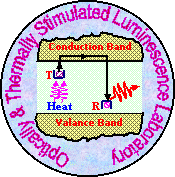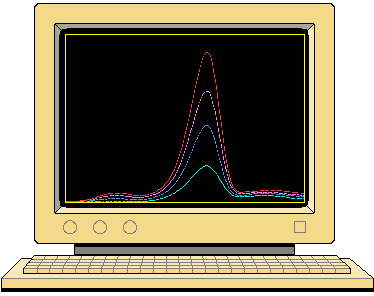 |
|
 |
| Our researces are mainly involved the study of defects
properties (i.e.defect models) and defect energy levels (i.e.trap depth)
in a variety of insulating (LiF:Mg,Ti, CaF2:Dy) and wide-band gap semiconducting
materials (ZnS), thermoluminescence kinetic mechanism, OSL&TL Dating,
applications and development of new computer glow curve deconvolution (CGCD)
programs. The experimental techniques employed involve optically or thermally
stimulated luminescence (OSL &TL), phototransfer thermoluminescence
(PTTL), emission spectrum (ES) and optical absorption (OA) measurements.
These methods (especially OSL & TL methods) have applications in environmental
dosimetry, personal dosimetry, high dose dosimetry, medical dosimetry,
retrospective (accident) dosimetry, space dosimetry and archaeological
dating.
We are particularly interested in solid state materials, the development of new materials and methods for use as radiation dosimetery using luminescence technique (Sponsored by Research Fund of Gaziantep University). A second major interest within this lab is the development of new techniques based on the simultaneously application UV and thermal treatments on the dosimetric materials to stabilize their sensitivity changes after repeted reuse. Our recent work has resulted on the TLD-100 (LiF:Mg,Ti) and as a result it was found that this new method gives best result than older methods. The another major interest in this lab is the application of OSL and TL luminescence dating procedures on quartz and feldspars (extracted from may arcological materials collected from around the Gaziantep City). Our most recent interest has concerned the effect of various experimental parameters (i.e.heating rate, storage time, annealing temperature,...) on the trapping parameters (i.e.trapping depth, frequency factor,...) of TLD-100 and TLD-200. Further studies have also been continuing on these subjects for other type of dosimetric materials. In our theoretical studies, we have also interested on the numerical modeling of the processes of TL and OSL production using mathematic programs (i.e. Mathematica and Mat-Lab). Numerical analysis of the rate equations describing the production of TL and OSL yield significant insight into the dynamics of the luminescence mechanisms. Based on this subject, we have investigated the effect of the temperature dependent frequency factor on the evaluated trapping parameters of TLD-100. |